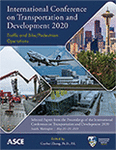International Conference on Transportation and Development 2020
Arterial Coordination Optimization Based on Trajectory Data
Publication: International Conference on Transportation and Development 2020
ABSTRACT
With the rapid development of urban traffic, the problem of urban traffic congestion is becoming more and more serious. Solving the traffic congestion of the main arterials of urban area is of great significance to alleviate the urban traffic congestion. Arterial coordination optimization is an effective method to improve arterial capacity, service level, and alleviate the urban traffic congestion. In this paper, an arterial coordination optimization model has been proposed with the analysis and processing of the vehicle trajectory. First, the characteristic trajectories are extracted according to the velocity distribution of the arterial line. Then, the intersection delay model is established to optimize the characteristic trajectories to obtain the phase difference for each intersection. The simulation result by SUMO software shows our method has 45.48% improvement in parking delay and 14.08% improvement in the average queue length at each intersection, which proves effectiveness of the proposed method.
Get full access to this article
View all available purchase options and get full access to this chapter.
REFERENCES
Cadez, I., Gaffney, S., & Smyth, P. (2000, March). A general probabilistic framework for clustering individuals. In Proc. of ACM SIGKDD (Vol. 2000).
Chang, E. C. P., & Messer, C. J. (1985). Minimum delay optimization of a maximum bandwidth solution to arterial signal timing. TRB.
Chang, E. C., & Messer, C. J. (1991). Arterial signal timing optimization using PASSER II-90-Program user’s manual.
Cohen, S. L. (1982). Concurrent use of the MAXBAND and TRANSYT signal timing programs for arterial signal optimization. Federal Highway Administration, Urban Transportation Management Division.
Cohen, S. L., & Liu, C. C. (1986). The bandwidth-constrained TRANSYT signal optimization program. Transportation Research Record, 1057, 1-7.
Day, C. M., & Bullock, D. M. (2016). Detector-Free Signal Offset Optimization with Limited Connected Vehicle Market Penetration: Proof-of-Concept Study. Transportation Research Record, 2558(1), 54-65.
Day, C. M., Li, H., Richardson, L. M., Howard, J., Platte, T., Sturdevant, J. R., & Bullock, D. M. (2017). Detector-free optimization of traffic signal offsets with connected vehicle data. Transportation Research Record, 2620(1), 54-68.
Gaffney, S., & Smyth, P. (1999, August). Trajectory clustering with mixtures of regression models. In KDD (Vol. 99, pp. 63-72).
Giannotti, F., Nanni, M., Pedreschi, D., Pinelli, F., Renso, C., Rinzivillo, S., & Trasarti, R. (2011). Unveiling the complexity of human mobility by querying and mining massive trajectory data. The VLDB Journal—The International Journal on Very Large Data Bases, 20(5), 695-719.
Hiribarren, G., & Herrera, J. C. (2014). Real time traffic states estimation on arterials based on trajectory data. Transportation Research Part B: Methodological, 69, 19-30.
Husch D, Albeck J., Synchro J. (2003). Traffic signal software, user guide.
Lee, J. G., Han, J., & Whang, K. Y. (2007, June). Trajectory clustering: a partition-and-group framework. In Proceedings of the 2007 ACM SIGMOD international conference on Management of data (pp. 593-604). ACM.
Li, Z., Lee, J. G., Li, X., & Han, J. (2010, April). Incremental clustering for trajectories. In International Conference on Database Systems for Advanced Applications (pp. 32-46). Springer, Berlin, Heidelberg.
Little, J. D., Kelson, M. D., & Gartner, N. H. (1981). MAXBAND: A versatile program for setting signals on arteries and triangular networks.
Messer, C. J., Whitson, R. H., Dudek, C. L., & Romano, E. J. (1973). A variable-sequence multiphase progression optimization program. Highway Research Record, 445(1973), 24-33.
Thiemann, C., Treiber, M., & Kesting, A. (2008). Estimating acceleration and lane-changing dynamics from next generation simulation trajectory data. Transportation Research Record, 2088(1), 90-101.
Wallace, C. E., & Courage, K. G. (1982). Arterial progression-New design approach. Transportation Research Record, 881, 53-59.
Wang, H., Zhang, G., Zhang, Z., & Wang, Y. (2016). Estimating control delays at signalised intersections using low-resolution transit bus-based global positioning system data. IET Intelligent Transport Systems, 10(2), 73-78.
Xianyu, W., Peifeng, H., & Zhenzhou, Y. (2013, June). Arterial Signal Timing Optimization Considering Speed Variation. In 2013 Fourth International Conference on Digital Manufacturing & Automation (pp. 311-314). IEEE.
Zheng, J., & Liu, H. X. (2017). Estimating traffic volumes for signalized intersections using connected vehicle data. Transportation Research Part C: Emerging Technologies, 79, 347-362.
Information & Authors
Information
Published In
International Conference on Transportation and Development 2020
Pages: 181 - 193
Editor: Guohui Zhang, Ph.D., University of Hawaii
ISBN (Online): 978-0-7844-8315-2
Copyright
© 2020 American Society of Civil Engineers.
History
Published online: Aug 31, 2020
Published in print: Aug 31, 2020
Authors
Metrics & Citations
Metrics
Citations
Download citation
If you have the appropriate software installed, you can download article citation data to the citation manager of your choice. Simply select your manager software from the list below and click Download.
